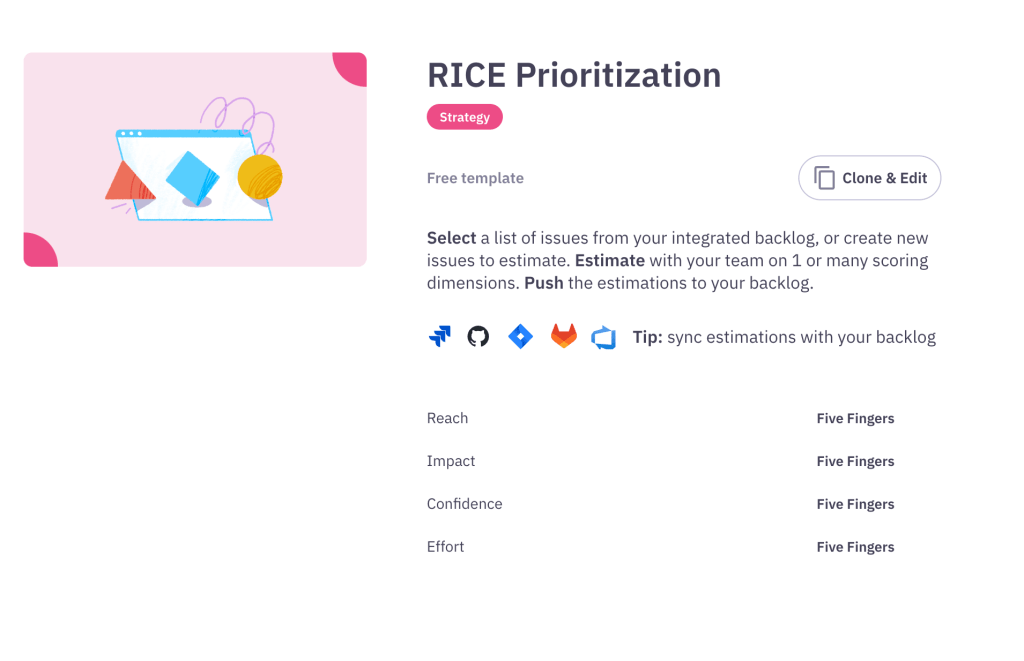RICE Prioritization Template

What is RICE prioritization?
The RICE prioritization framework involves ranking a given task or opportunity based on its Reach, Impact, Confidence, and Effort. It is an effective and commonly used framework for assessing and prioritizing projects or features. The RICE method was originally developed by Sean McBride of Intercom. RICE offers a structured approach to prioritization that is favored by many product teams – in particular product owners and product managers.
How do you do RICE prioritization?
For each given item being prioritized, you give a numerical score to indicate a high, low, or medium rating for each of the items. We call this the “RICE scoring model”. For example, if you were to use a 1-5 scale, an item with high reach and impact, but low confidence and low effort may have a score that looks like:
- Reach: 5
- Impact: 5
- Confidence: 1
- Effort: 1
Total RICE score: 12/20
When you’ve scored all opportunities available, you should end up with a prioritized list that can influence your product roadmap. The RICE framework helps you easily differentiate between low impact, high impact, and even gives the nuance to help you differentiate no impact and massive impact, depending on how refined your ranking scale is.
What does RICE stand for?
The RICE acronym stands for Reach, Impact, Confidence, and Effort.
- Reach (R): This element measures how many people or users a particular project or feature will impact. It’s about understanding the scale of your initiative.
- Impact (I): Impact assesses the potential benefits or significance of the project. It helps you identify the value it brings to your organization or users.
- Confidence (C): Confidence represents how certain you are about the accuracy of your Reach, Impact, and Effort estimations. It’s a crucial element to factor in to avoid overestimating or underestimating.
- Effort (E): Effort gauges the resources, time, and manpower required to complete the project or feature. It’s essential for assessing feasibility.
When to use RICE prioritization?
The RICE prioritization method’s strength lies in its ability to provide a clear and quantitative view of prioritization. It’s particularly useful when you have a pool of projects and need to decide which ones to tackle first. By assigning scores to each element, you can rank projects by their RICE score and focus on those with the highest potential.
RICE is great for decision-making when you need some quick wins, since it helps reveal the most impactful and least effort tasks. Since you can also see the items where you have a high confidence of success, there’s an opportunity for risk mitigation, too.
How to use the RICE prioritization template

Here’s a short overview of how to get started running a collaborative RICE prioritization workshop in Parabol. You can run your meeting alone, or bring in any internal or external stakeholders to prioritize as a team.
- Open the RICE prioritization template in Parabol, preferably ahead of any meeting you have planned so you can import all the items you want to prioritize.
- Set your RICE scoring model in Parabol. We’ve set a 1-5 scale (Five Fingers) as the default, but you can customize it if you want to.
- Import the items you want to prioritize from Jira, GitHub, or GitLab via integration, or add them in manually as Parabol tasks.
- Invite participants to join you in ranking items. In Parabol everyone can set their own blind RICE scores, and then you can compare and take an average.
- Schedule a call if you want to process and discuss trends together
- Independently rank items on the reach, impact, confidence, and effort parameters using the scale.
- Reveal the results and discuss/compare rankings with your team-mates.
- Set final RICE scores and optionally sync these scores automatically to your Jira, GitHub, or GitLab via Parabol’s two-way integration.
- Walk away with a fully prioritized list. End the meeting and receive an email summary with your prioritized list of items.